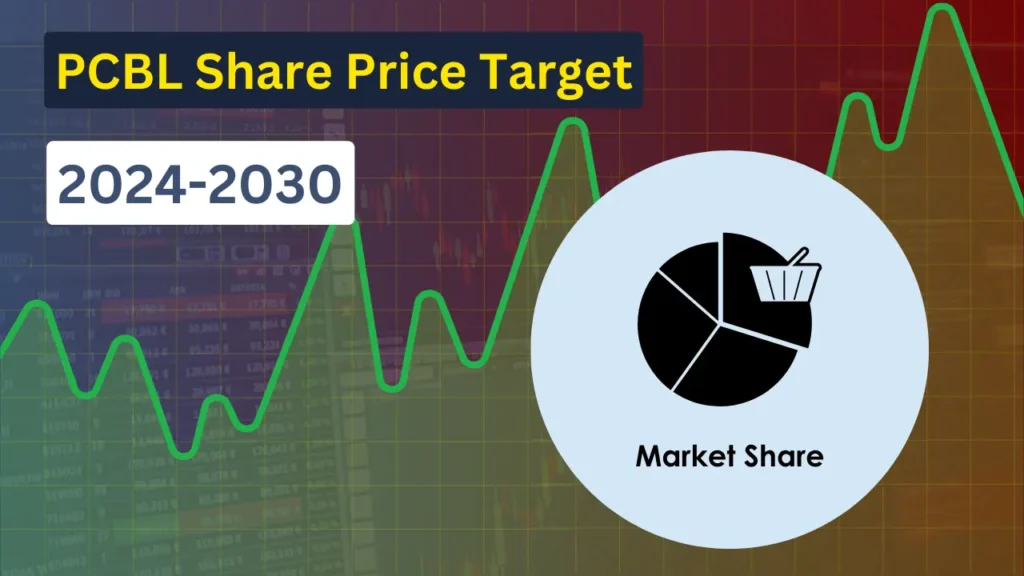Phillips Carbon Black Limited (PCBL), part of the RP-Sanjiv Goenka Group, is India’s largest carbon black producer and a major player in the global market.
Established in 1960, PCBL has grown significantly, with an annual production capacity of 7,70,000 metric tons and a renewable energy generation of 122 MW per hour.
PCBL supplies carbon black for industrial, automotive, and specialty applications, making it a key player in multiple markets.
This article analyzes PCBL’s share price forecasts for the years 2024 to 2030. We’ll explore financial performance, market conditions, and company goals to provide a thorough understanding of the stock’s future prospects.
The share price targets are based on verified data, industry analysis, and market trends, helping investors gauge the potential for long-term growth.

Current Market Overview (2024)
| Particulars | Data |
| Share Price (Oct 2024) | ₹495.36 |
| 52-Week High | ₹509.40 |
| 52-Week Low | ₹158.30 |
| P/E Ratio | 37.04 |
| Market Capitalization | ₹18,470 crore |
| Dividend Yield | 1.12% |
PCBL’s current market position reflects its solid financial standing and investor confidence. The stock’s steady growth in 2023 and early 2024 has set the stage for further expansion.

PCBL Share Price Target (2024 to 2030)
Here’s a detailed breakdown of PCBL’s projected share prices for each year from 2024 to 2030, with justifications based on financial data and market trends.
| Year | PCBL Share Price Target |
| PCBL share price target 2024 | ₹560 |
| PCBL share price target 2025 | ₹613 |
| PCBL share price target 2026 | ₹709 |
| PCBL share price target 2027 | ₹825 |
| PCBL share price target 2028 | ₹933 |
| PCBL share price target 2029 | ₹1185 |
| PCBL share price target 2030 | ₹1346 |
PCBL Share Price 2024 Target (₹560)
PCBL’s stock price is expected to reach ₹560 by the end of 2024, supported by strong demand in the automotive and tire sectors.
The company’s expansion into new global markets and increased production capacity will be key drivers of growth. PCBL is poised to take advantage of growing export opportunities, particularly in the automotive and industrial sectors.
Key Factors:
- Revenue: ₹21.44B (expected growth of 59.07% YoY)
- Operating Expenses: ₹4.21B (73.41% YoY increase due to capacity expansion)
- Net Income: ₹1.18B (+8.11% YoY)
- Long-Term PCBL Share Price Targets (2025 to 2030)
PCBL Share Price 2025 Target(₹613)
By 2025, PCBL’s focus on operational efficiency and increasing production capacity is expected to push its stock price to ₹613. With new production plants coming online and a growing international footprint, the company will continue to see revenue and profit growth.
PCBL Share Price 2026 Target (₹709)
In 2026, PCBL’s stock is likely to hit ₹709, driven by strong growth in the performance materials sector. The company’s focus on specialty chemicals, alongside its established carbon black production, will create diversified revenue streams.
Increased demand for high-performance materials in industries like plastics, coatings, and adhesives will further drive growth.
PCBL Share Price 2027 Target (₹825)
The stock price is projected to rise to ₹825 in 2027 as PCBL’s international business expands, especially in Asia and Europe.
New partnerships with automotive and tire manufacturers will enhance the company’s market share, while innovation in performance materials will drive additional revenue.
PCBL Share Price 2028 Target (₹933)
With investments in renewable energy and environmentally friendly production techniques, PCBL is forecasted to reach ₹933 by 2028.
This aligns with global trends toward sustainability, which will help PCBL secure more contracts, especially in Europe where environmental regulations are stringent.
PCBL Share Price 2029 Target (₹1185)
PCBL’s consistent growth trajectory positions it to reach ₹1185 by 2029. As the largest carbon black manufacturer in India, the company is likely to maintain its market dominance while expanding into new product lines in specialty chemicals. The continued investment in R&D and production capacity will support higher revenues.
PCBL Share Price 2030 Target (₹1346)
By 2030, PCBL is expected to hit ₹1346, bolstered by its leadership in the global carbon black market and a diverse portfolio of performance materials.
The company’s investments in green energy and strategic acquisitions will further strengthen its financial position.
Fundamental Ratios of PCBL Compared with Industry Averages
Understanding a company’s performance requires a thorough analysis of its financial ratios, which provide insight into its valuation, profitability, and financial stability.
Key Financial Ratios of PCBL (2024) vs. Industry Average
| Ratio | PCBL (2024) | Industry Average |
| Price-to-Earnings (P/E) | 37.04 | 24.50 |
| Price-to-Book (P/B) | 4.20 | 3.50 |
| Return on Equity (ROE) | 12.5% | 10% |
| Debt-to-Equity (D/E) | 0.42 | 0.65 |
| Current Ratio | 1.80 | 1.50 |
| Net Profit Margin | 5.51% | 7.00% |
1. Price-to-Earnings Ratio (P/E)
- PCBL (2024): 37.04
- Industry Average: 24.50
Analysis
PCBL’s P/E ratio of 37.04 is higher than the industry average, indicating that the stock is relatively overvalued compared to its peers.
This suggests that investors are paying a premium for PCBL’s future earnings, possibly due to its strong growth prospects, expansion into international markets, and dominance in the carbon black industry.
Justification:
While a high P/E ratio typically signals overvaluation, it can also indicate high investor expectations for future earnings growth.
In PCBL’s case, this premium valuation is driven by the company’s leadership position in India and its expansion efforts in global markets.
2. Price-to-Book Ratio (P/B)
- PCBL (2024): 4.20
- Industry Average: 3.50
Analysis
PCBL’s P/B ratio is slightly above the industry average, indicating that the company’s market value is higher relative to its book value. This suggests that investors are confident in PCBL’s growth potential and are willing to pay more than the intrinsic book value for the stock.
Justification
While this higher P/B ratio suggests that PCBL is more expensive compared to its assets, it can be justified by its strong brand value, market position, and future growth prospects in both domestic and international markets.
3. Return on Equity (ROE)
- PCBL (2024): 12.5%
- Industry Average: 10%
Analysis
PCBL’s ROE of 12.5% is above the industry average, reflecting the company’s efficient use of shareholder capital to generate profits. This is a positive indicator for investors, showing that the company is able to generate solid returns on its equity base.
Justification
A higher ROE indicates that PCBL has been effectively managing its resources, leading to better profitability compared to its peers.
This metric is particularly important for evaluating the company’s long-term sustainability and growth potential.
4. Debt-to-Equity Ratio (D/E)
- PCBL (2024): 0.42
- Industry Average: 0.65
Analysis
PCBL’s debt-to-equity ratio is lower than the industry average, suggesting that the company is conservatively leveraged. This is a positive sign, as it indicates that the company is not heavily reliant on debt to finance its operations, reducing its risk profile.
Justification
A lower D/E ratio reflects better financial stability and a lower risk of default, especially in a volatile market.
This gives PCBL a competitive edge, as it can invest in expansion without taking on excessive debt, which is particularly important given the cyclical nature of the carbon black industry.
5. Current Ratio
- PCBL (2024): 1.80
- Industry Average: 1.50
Analysis
PCBL’s current ratio is higher than the industry average, indicating that the company has a good liquidity position and is capable of covering its short-term liabilities with its short-term assets.
Justification
A higher current ratio demonstrates PCBL’s ability to meet its obligations without financial strain, which is crucial in maintaining investor confidence.
This ratio shows that the company has effectively managed its working capital, which is important for sustaining day-to-day operations.
6. Net Profit Margin
- PCBL (2024): 5.51%
- Industry Average: 7.00%
Analysis
PCBL’s net profit margin is below the industry average, indicating that the company is currently facing some pressure on its profitability.
This could be due to rising raw material costs, competition, or operational inefficiencies.
Justification
While the net profit margin is lower, PCBL’s strategic initiatives such as operational improvements and cost-cutting measures are expected to help the company improve its margins over the coming years. Additionally, its investments in renewable energy and green technologies may help offset some of these challenges in the future.
PCBL Financial Performance
PCBL’s financial performance has been on an upward trajectory, with substantial revenue growth, efficient cost management, and consistent profitability. Here’s a closer look at the company’s key financial metrics:
| Metric | PCBL (2024) | YoY |
| Revenue | ₹21.44 Billion | +59.07% |
| Net Profit | ₹1.18 Billion | +8.11% |
| EBITDA | ₹3.20 Billion | +61.09% |
| Earnings Per Share (EPS) | ₹3.13 | Stable |
Revenue: PCBL has consistently increased its revenues, with expected growth of 59.07% YoY in 2024.
Net Profit: The company’s net profit is expected to increase by 8.11% YoY in 2024, reflecting strong operational efficiency.
EBITDA: EBITDA is expected to grow by 61.09% YoY, supported by higher production and better cost management.
Earnings Per Share (EPS): Stable at ₹3.13, reflecting PCBL’s solid financial health.
Industry Trends and Market Analysis
The global carbon black market is forecasted to grow at a CAGR of 6.5% over the next five years, driven by the increasing demand for carbon black in tires, automotive components, and industrial applications. PCBL, as India’s largest producer, is well-positioned to benefit from this trend.
Key Industry Drivers:
Automotive Sector: The rising demand for electric vehicles and energy-efficient tires will increase the need for high-performance carbon black.
Industrial Applications: Carbon black’s use in plastics, coatings, and electronics is expected to drive future growth.
Environmental Regulations: PCBL’s investment in renewable energy and green production methods will help it stay competitive in regions with strict environmental laws.
Risks and Challenges
Despite its strong market position, PCBL faces certain risks:
Industry Cyclicality: Fluctuations in the automotive and tire industries could impact demand for carbon black.
Raw Material Price Volatility: The rising costs of oil and natural gas could pressure profit margins.
Regulatory Risks: Stricter environmental regulations may lead to higher compliance costs.
However, PCBL’s focus on innovation, operational efficiency, and sustainability should help it mitigate these risks.
Conclusion
PCBL’s stock offers a promising growth trajectory for long-term investors. The company’s leadership in the carbon black industry, coupled with its diversification into specialty chemicals and green energy, positions it well for sustained growth over the next decade.
While the company faces certain challenges, such as raw material price volatility and regulatory risks, its strong financial performance and forward-looking strategy mitigate these concerns.
Investors looking for a growth stock in the specialty chemicals sector should consider PCBL for their portfolio, as it offers strong fundamentals, consistent profitability, and a clear path for future expansion.

Roshan Sharma – Founder of StocksForBeginners.in
I’m Roshan Sharma, a stock market trader with 5+ years of experience. At StocksForBeginners.in, I provide expert fundamental analysis of Indian companies to help long-term investors make informed decisions. My mission is to simplify investing for beginners and share insights from my experience to guide others toward financial growth.